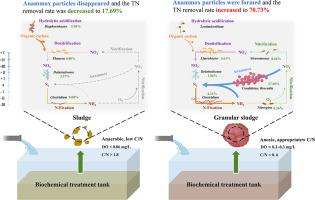当前位置:
X-MOL 学术
›
Water Res.
›
论文详情
Our official English website, www.x-mol.net, welcomes your
feedback! (Note: you will need to create a separate account there.)
Micro-aeration and low influent C/N are key environmental factors for achieving ANAMMOX in livestock farming wastewater treatment plants
Water Research ( IF 11.4 ) Pub Date : 2023-05-31 , DOI: 10.1016/j.watres.2023.120141 Yuxin Li , Zhenzhong Pan , Jingsong Liao , Ruizhi Dai , Jih-Gaw Lin , Jiayin Ling , Yanbin Xu
Water Research ( IF 11.4 ) Pub Date : 2023-05-31 , DOI: 10.1016/j.watres.2023.120141 Yuxin Li , Zhenzhong Pan , Jingsong Liao , Ruizhi Dai , Jih-Gaw Lin , Jiayin Ling , Yanbin Xu

|
Anaerobic ammonium oxidation (ANAMMOX)-mediated system is a cost-effective green nitrogen removal process. However, there are few examples of successful application of this advanced wastewater denitrification process in wastewater treatment plants, and the understanding of how to implement anaerobic ammonia oxidation process in full-scale is still limited. In this study, it was found that the abundance of anaerobic ammonia-oxidizing bacteria (AnAOB) in the two livestock wastewater plants named J1 and J2, respectively, showed diametrically opposed trends of waxing and waning with time. The microbial communities of the activated sludge in the two plants at different time were sampled and analyzed by high-throughput sequencing of 16S rRNA genes. Structural equation models (SEMs) were used to reveal the key factors affecting the realization of the ANAMMOX. Changes in the concentration of dissolved oxygen and C/N had a significant effect on the relative abundance of anaerobic ammonia oxidation bacteria (AnAOB). The low concentration of DO (0.2∼0.5 mg/L) could inhibit the activity of nitrifying bacteria (NOB) to achieve partial oxidation of ammonia nitrogen and provide sufficient substrate for the growth of AnAOB, similar to the CANON (Completely Autotrophic Nitrogen removal Over Nitrite). Unlike CANON, heterotrophic denitrification is also a particularly critical part of the livestock wastewater treatment, and a suitable C/N of about 0.6 could reduce the competition risk of heterotrophic microorganisms to AnAOB and ensure a good ecological niche for AnAOB. Based on the results of 16S rRNA and microbial co-occurrence networks, it was discovered that microorganisms in the sludge not only had a richer network interaction, but also achieved a mutually beneficial symbiotic interaction network among denitrifying bacteria (Pseudomonas sp., Terrimonas sp., Dokdonella sp.), AnAOB (Candidatus Brocadia sp.) at DO of 0.2∼0.5 mg/L and C/N of 0.6. Among the top 20 in abundance of genus level, AnAOB had a high relative abundance of 27.66%, followed by denitrifying bacteria of 3.67%, AOB of 0.64% and NOB of 0.26%, which is an essential indicator for the emergence of an AnAOB-dominated nitrogen removal cycle. In conclusion, this study highlights the importance of dissolved oxygen and C/N regulation by analyzing the mechanism of ANAMMOX sludge extinction and growth in two plants under anthropogenic regulation of AnAOB in full-scale wastewater treatment systems.
中文翻译:

微曝气和低进水C/N是畜牧业废水处理厂实现厌氧氨氧化的关键环境因素
厌氧氨氧化(ANAMMOX)介导的系统是一种经济高效的绿色脱氮工艺。然而,这种先进的废水脱氮工艺在废水处理厂中成功应用的例子很少,对如何全面实施厌氧氨氧化工艺的了解仍然有限。本研究发现,J1和J2两个畜牧废水处理厂中厌氧氨氧化细菌(AnAOB)的丰度随着时间的推移呈现出截然相反的增减趋势。对两个厂不同时间活性污泥的微生物群落进行采样,通过16S rRNA基因高通量测序进行分析。利用结构方程模型(SEM)揭示了影响厌氧氨氧化实现的关键因素。溶解氧浓度和C/N的变化对厌氧氨氧化细菌(AnAOB)的相对丰度有显着影响。低浓度的DO(0.2∼0.5 mg/L)可以抑制硝化细菌(NOB)的活性,实现氨氮的部分氧化,为AnAOB的生长提供充足的底物,类似于CANON(完全自养脱氮)亚硝酸盐)。与CANON不同,异养反硝化也是畜牧废水处理中尤为关键的一环,合适的C/N在0.6左右可以降低异养微生物对AnAOB的竞争风险,保证AnAOB良好的生态位。 基于16S rRNA和微生物共生网络的结果发现,污泥中的微生物不仅具有更丰富的网络相互作用,而且反硝化细菌(Pseudomonas sp.、Terrimonas sp.、Terrimonas sp.)之间也实现了互利共生的相互作用网络。 、Dokdonella sp.)、AnAOB(Candidatus Brocadia sp.),DO 为 0.2∼0.5 mg/L,C/N 为 0.6。在属丰度前20位中,AnAOB的相对丰度较高,为27.66%,其次是反硝化菌,为3.67%,AOB为0.64%,NOB为0.26%,这是AnAOB出现的重要指标。占主导地位的脱氮循环。总之,本研究通过分析全规模废水处理系统中 AnAOB 人为调节下两个工厂中 ANAMMOX 污泥的消亡和生长机制,强调了溶解氧和 C/N 调节的重要性。
更新日期:2023-05-31
中文翻译:

微曝气和低进水C/N是畜牧业废水处理厂实现厌氧氨氧化的关键环境因素
厌氧氨氧化(ANAMMOX)介导的系统是一种经济高效的绿色脱氮工艺。然而,这种先进的废水脱氮工艺在废水处理厂中成功应用的例子很少,对如何全面实施厌氧氨氧化工艺的了解仍然有限。本研究发现,J1和J2两个畜牧废水处理厂中厌氧氨氧化细菌(AnAOB)的丰度随着时间的推移呈现出截然相反的增减趋势。对两个厂不同时间活性污泥的微生物群落进行采样,通过16S rRNA基因高通量测序进行分析。利用结构方程模型(SEM)揭示了影响厌氧氨氧化实现的关键因素。溶解氧浓度和C/N的变化对厌氧氨氧化细菌(AnAOB)的相对丰度有显着影响。低浓度的DO(0.2∼0.5 mg/L)可以抑制硝化细菌(NOB)的活性,实现氨氮的部分氧化,为AnAOB的生长提供充足的底物,类似于CANON(完全自养脱氮)亚硝酸盐)。与CANON不同,异养反硝化也是畜牧废水处理中尤为关键的一环,合适的C/N在0.6左右可以降低异养微生物对AnAOB的竞争风险,保证AnAOB良好的生态位。 基于16S rRNA和微生物共生网络的结果发现,污泥中的微生物不仅具有更丰富的网络相互作用,而且反硝化细菌(Pseudomonas sp.、Terrimonas sp.、Terrimonas sp.)之间也实现了互利共生的相互作用网络。 、Dokdonella sp.)、AnAOB(Candidatus Brocadia sp.),DO 为 0.2∼0.5 mg/L,C/N 为 0.6。在属丰度前20位中,AnAOB的相对丰度较高,为27.66%,其次是反硝化菌,为3.67%,AOB为0.64%,NOB为0.26%,这是AnAOB出现的重要指标。占主导地位的脱氮循环。总之,本研究通过分析全规模废水处理系统中 AnAOB 人为调节下两个工厂中 ANAMMOX 污泥的消亡和生长机制,强调了溶解氧和 C/N 调节的重要性。











































 京公网安备 11010802027423号
京公网安备 11010802027423号